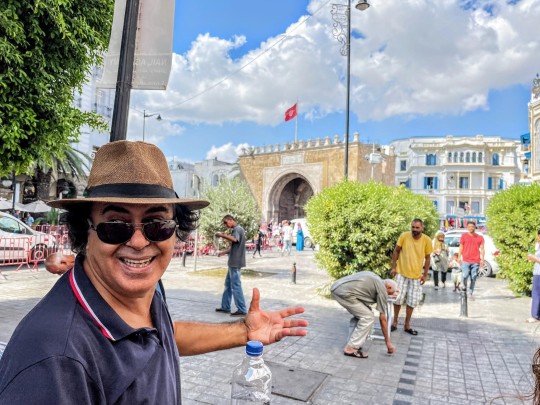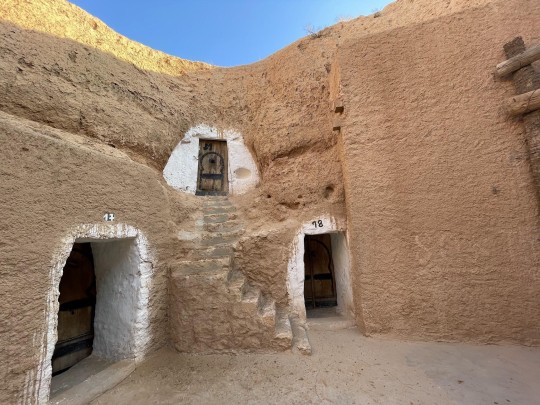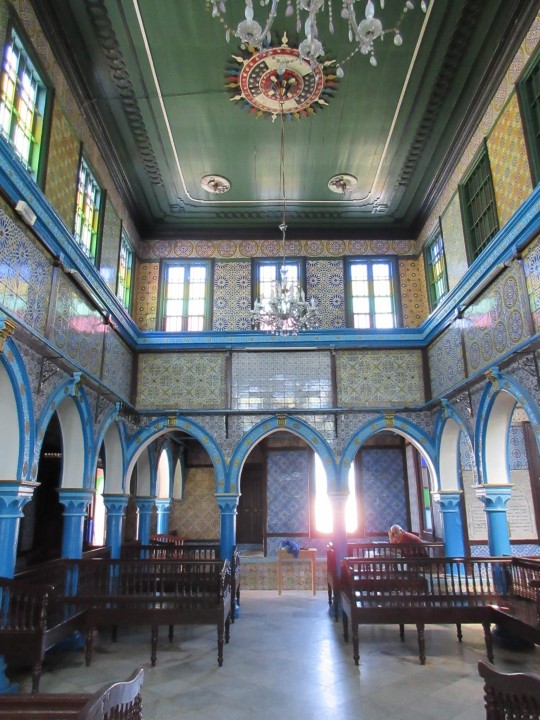Don't wanna be here? Send us removal request.
Text
Aiden Greiff
In pursuit of cultural exploration and historical insight, our group embarked on a journey to the southern regions of Tunisia, specifically Djerba, Matmata, and the Colosseum in Al Gem. This essay documents our experiences in a more formal manner, focusing on the observed details and historical significance of these locations.
Our first destination was Djerba, an island situated off the eastern coast of Tunisia. Djerba’s medina, is characterized by a labyrinthine network of narrow streets and bustling markets. This area exudes the essence of local life, with vendors peddling a variety of wares, including fresh spices and handmade crafts. It is a hub of commerce and culture, showcasing the essence of Tunisian daily life.
Our journey then led us to Matmata, a troglodyte village renowned for its subterranean dwellings. These underground homes, termed “منازل تحت الأرض” (manāzil taḥt al-arḍ) in Arabic, are a testament to the resourcefulness of the Amazirgh people who have historically lived in this region. The unique architecture of these homes offers respite from the arid climate of the Tunisian desert, using the earth itself as a natural insulator. Our experience in Matmata shed light on the enduring traditions and lifestyles of the inhabitants, a stark contrast to urban existence. There was also a large Jewish presence in the region, which was very interesting to learn about.
The lst major stop of our journey was a visit to the Colosseum in Al Gem. This historical monument, characterized by its massive scale and architectural grandeur, stood as a symbol of Tunisia’s rich historical legacy, and colonialist legacy. A term that resonated during our visit was “مدرج” (madraj), an Arabic word for amphitheater. This colossal structure provided a setting for various events and spectacles in antiquity, showcasing the historical influence and significance of the region.
In conclusion, our journey through southern Tunisia exposed us to a diverse range of cultural and historical facets. Djerba’s medina epitomized the vibrancy of local life, Matmata offered an insight into ancient living practices, and the Colosseum in Al Gem illuminated Tunisia’s historical grandeur. As we departed this region, we were left with a profound appreciation for the heritage and vitality of southern Tunisia, a perspective that will resonate in our memories for years to come.
1 note
·
View note
Text
قندقنا, يبني في أسلوب الأمازيغ

#tunisia#amazigh#north africa#study abroad#language journal#language blog#language learning#experiential learning
0 notes
Text

0 notes
Text
قندقنا, يبني في أسلوب الأمازيغ

#north africa#tunisia#study abroad#language and culture#language learning#language journal#LANGUAGE BLOG
0 notes
Text
George Ashford
10/11/2023
Reflection
Traveling through Tunisia, I saw the marks of the many cultures that have found a home here throughout history. A Roman coliseum. Amazigh villages carved into the desert. A Sunni mosque made of Roman columns and a Shi'a fortress guarded by Ottoman cannons. The monumental art-deco and brutalist structures of the capital. An ancient synagogue rumored to contain stones from another, even more ancient temple that stood where Abraham obeyed and Isaac was spared. They tell a story that spans thousands of years, a story of colonization, assimilation, war, and the advent of a nation.
One part of the story begins on the island of Djerba. The Ghriba Synagogue, purportedly the oldest Jewish site in Africa, sits near the center. No one knows for certain how old it is, but legend has it that the high priests of the Temple Mount fled to Djerba after Nebuchadnezzar and the Bablylonians sacked Jerusalem, carrying a stone and a door from the First Temple to build anew. As he shows us around a traditional Amazigh house, dug two stories deep into the soft desert dirt, a light-eyed man in a baseball camp explains that his people were once Jewish. That is why they sheltered Jews during the holocaust, he says, pointing to a metal helmet from WWII hung on a stick bannister. With a few exceptions, the Amazigh are not Jewish anymore, as evidenced by the woman in hijab who serves us tea while we watch the sunset wash over the small circle of sky visible from the open pit at the center of the house, but the man is proud to tell us that they once were. He is staking a claim to Tunisia’s story, reminding us that it began before the Arabs arrived, and that his ancestors were here before Islam. Although he does not make it a point to tell us, they were here before Judaism too.
In Kairouan, conquests are layered onto one another in the very foundations of the city. As we look out over the massive cisterns that held the water for the ascendant Umayyad caliphate’s first outpost in the region, we learn that it gets its name from the Arabic word for a military caravan. The outpost was to protect the new settlers from the Amazigh, who staged a series of successful rebellions before being defeated and gradually converting to Islam. We do not have to explore Kairouan for long, however, to see that the The Umayyads were not the first conquerors to make their mark here. The columns of the majestic Great Mosque of Kairouan are carved in the Greco-Roman style, clearly repurposed from older buildings. Some of the stones in the outer wall have latin writing on them. 70 kilometers away, closer to the coast, the towering Roman amphitheater in El-Jem testifies more explicitly to the power of the empire that counted this part of North Africa among its first and hardest won territories.
After El-Jem, we stop in Mahdia. The insurgent Fatimid caliphate, tracing their lineage back to the Prophet’s daughter, founded the city as their first capital a few hundred years after the Umayyads founded Kairouan. They would go on to capture Egypt and the rest of North Africa from the ruling Abbasid dynasty, spelling the end of a united Arab empire in the Mediterranean. We walk along the parapet of a fortress looking out over bright blue ocean on three sides. We imagine seeing
ships coming over the horizon and scrambling to man the defenses, as so many must have over the centuries. Genoese, Norman, Spanish, French, and Ottoman raiders all came by sea to Mahdia, its well-fortified harbor making it a prime toehold for a long line of would-be conquerors.
The latest conqueror in that line is most visible in Tunis, where art-deco facades adorn the most prominent buildings in the city center. It is also audible in the French words and accent woven into Tunisia’s unique dialect of Arabic. Tunis also, however, tells of something new. Hulking government buildings and hotels made from the ubiquitous concrete of the late 20th century overlook Habib Bourguiba Avenue. They proclaim the sovereignty of a people that is not quite of the ancient desert tribes nor any of their conquerors. Our professor points out the site of famous protests where Tunisians proclaimed a more personal form of sovereignty, demanding political freedom and economic opportunity and getting at least the former.
Tunisia is an Arab country. Hearing the language and the call to prayer every day make that clear, and Kairouan tells the story of how it became so. It is not, however, a solely Arab country, just as the story of Kairouan is not Tunisia’s only story. Djerba, El-Jem, Tunis, Mahdia, and the Amazigh villages tell other stories about Tunisia, stories that include elements of the French story, the Jewish story, the Ottoman story, the Roman story, and the story of the Amazigh. With revolution for national, and then for personal independence as the most recent chapters, they weave together into one, rich, cohesive, Tunisian story. It has been a fascinating story to learn these past few months, and I look forward to someday knowing it in more detail.
Expressions
One of the most common Tunisian expressions is to say صحة when someone is eating, gets out of the shower, or buys new clothes. The response is يا أتك صحة. The expression literally translates just to ‘health,’ and expresses encouragement of healthy activities like eating.
ما يْحِس بِالجمْرة كان الّي يعْفِس عْليها is a less common Tunisian proverb that translates literally to ‘only he who walks on embers can feel it.’ It expresses the idea that one should not judge or criticize the struggles of someone else, since it is impossible to know what they are really going through.
Photos
أركان رومانية في جامع قيروان الأكبر
George Ashford
10/11/2023
Reflection
Traveling through Tunisia, I saw the marks of the many cultures that have found a home here throughout history. A Roman coliseum. Amazigh villages carved into the desert. A Sunni mosque made of Roman columns and a Shi'a fortress guarded by Ottoman cannons. The monumental art-deco and brutalist structures of the capital. An ancient synagogue rumored to contain stones from another, even more ancient temple that stood where Abraham obeyed and Isaac was spared. They tell a story that spans thousands of years, a story of colonization, assimilation, war, and the advent of a nation.
One part of the story begins on the island of Djerba. The Ghriba Synagogue, purportedly the oldest Jewish site in Africa, sits near the center. No one knows for certain how old it is, but legend has it that the high priests of the Temple Mount fled to Djerba after Nebuchadnezzar and the Bablylonians sacked Jerusalem, carrying a stone and a door from the First Temple to build anew. As he shows us around a traditional Amazigh house, dug two stories deep into the soft desert dirt, a light-eyed man in a baseball camp explains that his people were once Jewish. That is why they sheltered Jews during the holocaust, he says, pointing to a metal helmet from WWII hung on a stick bannister. With a few exceptions, the Amazigh are not Jewish anymore, as evidenced by the woman in hijab who serves us tea while we watch the sunset wash over the small circle of sky visible from the open pit at the center of the house, but the man is proud to tell us that they once were. He is staking a claim to Tunisia’s story, reminding us that it began before the Arabs arrived, and that his ancestors were here before Islam. Although he does not make it a point to tell us, they were here before Judaism too.
In Kairouan, conquests are layered onto one another in the very foundations of the city. As we look out over the massive cisterns that held the water for the ascendant Umayyad caliphate’s first outpost in the region, we learn that it gets its name from the Arabic word for a military caravan. The outpost was to protect the new settlers from the Amazigh, who staged a series of successful rebellions before being defeated and gradually converting to Islam. We do not have to explore Kairouan for long, however, to see that the The Umayyads were not the first conquerors to make their mark here. The columns of the majestic Great Mosque of Kairouan are carved in the Greco-Roman style, clearly repurposed from older buildings. Some of the stones in the outer wall have latin writing on them. 70 kilometers away, closer to the coast, the towering Roman amphitheater in El-Jem testifies more explicitly to the power of the empire that counted this part of North Africa among its first and hardest won territories.
After El-Jem, we stop in Mahdia. The insurgent Fatimid caliphate, tracing their lineage back to the Prophet’s daughter, founded the city as their first capital a few hundred years after the Umayyads founded Kairouan. They would go on to capture Egypt and the rest of North Africa from the ruling Abbasid dynasty, spelling the end of a united Arab empire in the Mediterranean. We walk along the parapet of a fortress looking out over bright blue ocean on three sides. We imagine seeing
ships coming over the horizon and scrambling to man the defenses, as so many must have over the centuries. Genoese, Norman, Spanish, French, and Ottoman raiders all came by sea to Mahdia, its well-fortified harbor making it a prime toehold for a long line of would-be conquerors.
The latest conqueror in that line is most visible in Tunis, where art-deco facades adorn the most prominent buildings in the city center. It is also audible in the French words and accent woven into Tunisia’s unique dialect of Arabic. Tunis also, however, tells of something new. Hulking government buildings and hotels made from the ubiquitous concrete of the late 20th century overlook Habib Bourguiba Avenue. They proclaim the sovereignty of a people that is not quite of the ancient desert tribes nor any of their conquerors. Our professor points out the site of famous protests where Tunisians proclaimed a more personal form of sovereignty, demanding political freedom and economic opportunity and getting at least the former.
Tunisia is an Arab country. Hearing the language and the call to prayer every day make that clear, and Kairouan tells the story of how it became so. It is not, however, a solely Arab country, just as the story of Kairouan is not Tunisia’s only story. Djerba, El-Jem, Tunis, Mahdia, and the Amazigh villages tell other stories about Tunisia, stories that include elements of the French story, the Jewish story, the Ottoman story, the Roman story, and the story of the Amazigh. With revolution for national, and then for personal independence as the most recent chapters, they weave together into one, rich, cohesive, Tunisian story. It has been a fascinating story to learn these past few months, and I look forward to someday knowing it in more detail.
Expressions
One of the most common Tunisian expressions is to say صحة when someone is eating, gets out of the shower, or buys new clothes. The response is يا أتك صحة. The expression literally translates just to ‘health,’ and expresses encouragement of healthy activities like eating.
ما يْحِس بِالجمْرة كان الّي يعْفِس عْليها is a less common Tunisian proverb that translates literally to ‘only he who walks on embers can feel it.’ It expresses the idea that one should not judge or criticize the struggles of someone else, since it is impossible to know what they are really going through.
Photos
أركان رومانية في جامع قيروان الأكبر
كنيس الغريبة في جربة
كنيس الغريبة في جربة
0 notes
Text
Michaela’s First Blog Post
Story
ذهبت إلى حفل زفاف مع أمي وأختي المضيفة.وصلنا أولاً وجلسنا. كانت الغرفة صغيرة ولكنها كانت جميلة جداً. كل شيء كان أبيض ولكن الأضواء كانت أرجوانية. بالإضافة إلى ذلك كانت الزهور على كل طاولة. وصلت العروس في ثوب أبيض كبير. ظنت أنه جميل! حفلات الزفاف في تونس مختلفة جدا عن حفلات الزفاف في الولايات المتحدة. في هذا حفل الزفاف هذا كانت الموسيقى عالية جدا! لم أتمكن من سماع أي شيء آخر! بالإضافة إلى ذلك في الولايات المتحدة تأكل الكعكة ونشرب الخمر ولكن في تونس أكلنا الحلويات وشربنا عصير الفاكهة. ايضا في الولايات المتحدة حفل زفاف يوم واحد فقط ولكن في تونس حفل زفاف سبعة أيام. بالنسبة لي حفلات الزفاف في كلا البلدين جميلة.
Words of the Week:
شوية شوية! (Shwaya Shwaya)
“Little little!” I use this handy phrase multiple times a day. It can be used to tell someone to slow down when they’re walking too fast or when your host mom is attempting to pile on another huge scoop of couscous.
Joke:
فإما واحد حب يمشي ويمشي محبتوش
There is a guy who wanted to go and to go he didn’t want.
A joke given to me by my wonderful coordinator Rahma!
6 notes
·
View notes
Text
1 note
·
View note
Text
Michaela’s First Blog Post
Story
ذهبت إلى حفل زفاف مع أمي وأختي المضيفة.وصلنا أولاً وجلسنا. كانت الغرفة صغيرة ولكنها كانت جميلة جداً. كل شيء كان أبيض ولكن الأضواء كانت أرجوانية. بالإضافة إلى ذلك كانت الزهور على كل طاولة. وصلت العروس في ثوب أبيض كبير. ظنت أنه جميل! حفلات الزفاف في تونس مختلفة جدا عن حفلات الزفاف في الولايات المتحدة. في هذا حفل الزفاف هذا كانت الموسيقى عالية جدا! لم أتمكن من سماع أي شيء آخر! بالإضافة إلى ذلك في الولايات المتحدة تأكل الكعكة ونشرب الخمر ولكن في تونس أكلنا الحلويات وشربنا عصير الفاكهة. ايضا في الولايات المتحدة حفل زفاف يوم واحد فقط ولكن في تونس حفل زفاف سبعة أيام. بالنسبة لي حفلات الزفاف في كلا البلدين جميلة.
Words of the Week:
شوية شوية! (Shwaya Shwaya)
“Little little!” I use this handy phrase multiple times a day. It can be used to tell someone to slow down when they’re walking too fast or when your host mom is attempting to pile on another huge scoop of couscous.
Joke:
فإما واحد حب يمشي ويمشي محبتوش
There is a guy who wanted to go and to go he didn’t want.
A joke given to me by my wonderful coordinator Rahma!
6 notes
·
View notes
Text
Nina’s Second Blog Post!
اليوم، ذهبت إلى حفلة في مركز دراسة المغرب العربي. ذهبت إلى حفلة مع زميلي و أستاذي. كانت حفلة لافتتاح المركز. كان هناك أناس كثير. منهم كان أساتذة و فنانين و آصدقاء. تعرفت على طالبين من أمريكا و رئيسة المركز. في المركز هناك مكتبة كبيرة. وجدت كتب كثيرة التي اريد أن أقراهم. أكلت طعام كثيرة أثناء الحفلة. كان هناك كيكة لذيذ! امنيتي أن اذهب إلي مركز دراسة المغرب مرة أخرى.
لاباس
La Bas is a saying in Tunsi similar to “ça va” in French. It is both a question and a response. Asking “La bas?” is like asking “how are you?“ to someone and responding with “la bas” confirming you’re doing well! Similar to ça va, la bas is a greeting, question, and response all in one!
نكتة
Person 1: Ça va?
Person 2: Cent dix!
In Tunsi, the question “ça va?” sounds similar to “cent vingt” which means 120. A funny response to this question is to say "cent dix” meaning 110.
3 notes
·
View notes
Text

Word of the Week 1: tool tool
tool, or tool tool, means “straight ahead” in English. It’s often used to give directions. In Tunsi, words are commonly said twice. It’s the word of the week because it’s fun to say.
Joke 1: My host mom told me a Tunisian joke about students in an English class.
The professor is teaching conjugation. She calls on one kid and says, “conjugate: to write.” The kid says, “write, wrote, written.” She points at another student and says, “to speak.” The student says, “speak, spoke, spoken.” Then, she calls on a kid with his head down who is not paying attention and says, “sbeek!” (what’s up with you!) He jerks up and says, “shbeek, shbeeked, shbeeken.”
Word of the Week 2: Dar
Dar means house in Tunsi.
Joke 2:
I made this joke up because I love all the cats in Tunisia. It is a dumb joke.
What does the cat say in FusHa? “Maaow.” What does the cat say in Tunsi? “Meh ow.”
The joke is Tunsians change “ah” sounds to “eh” sounds. Instead of Sebah Al Khair, they say Sbeh al Kheer.
Cait Kelley
1 note
·
View note
Text
Saleh’s Second Blog
في صباح الأمس، ذهبت إلى مدرستي في سيدي بو سعيد في العاشرة صباحا. انا و طلاب آخرون درسنا لان كان هناك امتحان و تقديمات. ثم، اكلت ساندوتش من مطعم “شيّ علي” قريب من مسجد سيدي بو سعيد. كنت خائفا جدا لامتحاني ولكن فعلت هو! بعد الامتحان انا تكلمت عن شخصياتي المفضلة. تكلمت عن رجل عنكبوت و ثانوس و بيجيتا و شاهدنا مقتطفات من افلام و سلسلة مع هذا شخصيات. ثم، ذهبت الى عاصمة تونس لكي أمكنت ان اجتمعت مع رجل من منظمة اسمة “منمتي” او حلمي بالعربية. كان هذا يوم طويل جدًا.
Word of the week: إمش
“Emshi” is used in Tunisian Arabic and is a command word meaning “go!” I usually end up using “emshi” on my host family’s dog Lola when she comes into my room.
Joke: “Ya illlahi ya moujiba da3awetiii ij3al Al imti7ana sahlan w el ostetha kathir alghiyabatiii”
This prayer or invocation of God is used humorously among Tunisian students and basically begs God to make their test easy and their teacher absent so either they don’t struggle with the test or they don’t have to take it because their professor is missing.
1 note
·
View note





